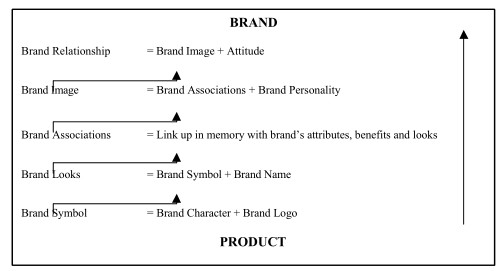The spirit of the brand can only be inferred through its products and its advertising .The content of the brand grows out of the cumulative memory of various acts provided they are governed by a set of unifying ideas or guidelines. The importance of memory in encompassing a brand explains why its image can vary structurally from generation to generation.
Consumers are human beings. They know brands, express about brands, think about brands, feel about brands, compare brands, compare brands, choose brands, recommend brands, reject brands, buy brands, and do not buy brands through a combination of –
- Brand name
- Brand associations
- Brand attitude
- Brand looks
- Brand personality
All these are not just a matter of semantics. These are specific manageable concepts, born and brought up in the minds and hearts of the consumers, linked to each other in more ways than one. These, if ‘added’ to a product, lead to creation of a brand. These form part of the suggested process of Branding, and together lead to Brand Relationship, the output of the process of branding. The fig links up all these and forms the model, which is labeled as Branding.

As per the Branding Model, which in a way is a branding process?
- Brand Relationship is the ultimate achievement-need of branding. All other aspects (e.g. Brand Positioning) might happen but if this does not happen the job is not complete. Brand Relationship happens if ‘image’ and ‘attitude’ for a brand exist. It is the resultant effect of these two aspects of a brand.
- Brand Attitude defines what the brand thinks about the consumer, as per the consumer. A brand may have ‘attitude’ on one or more aspects.
- Brand Image includes two aspects of a brand– its associations and its personality. A brand may have image on one or more aspects.
- Brand Associations include all that is linked up in memory about the brand. It could be specific to attributes, features, benefits or looks of the brand. A brand may have a range of associations. But the one association that stands out in memory and differentiates it becomes the ‘position’ of the brand. A brand may have one or more associations but no ‘position’.
- For a brand to have brand relationship, it should have ‘image’. And for ‘image’ a brand should have ‘association’. If among its ‘associations’, a brand has a ‘position’ it is a great advantage. But if a brand does not have a ‘brand position’ it does not mean that it would have a brand image or brand relationship. In other words, ‘brand position’ is not a sufficient condition for brand relationship, but a ‘highly desirable’ condition.
- Brand Looks, which have a role to play in forming/ reinforcing brand association are facilitated by two key properties of a brand – its name and its symbol. While brand name is a necessary condition for existence of brand relationship, the same is true for brand symbol. However, if the latter exists it helps the process of brand relationship and reinforces it.
- Brand Symbol includes two visual signals of a brand- its character (e.g. Amul girl, Pillsbury doughboy) and its logo.
- ‘Necessary’ aspects for brand relationship to exist are –
- Brand Name
- Brand Associations
- Brand Attitude
- ‘Highly desirable’ aspects for brand relationship to exist are (excluding the ‘necessary’ aspects) –
- Brand position and
- Brand symbol
The model is a process. It has linked up steps. It is dynamic. It never ends. And it is all to do about managing the minds of the people and aspects about a product, thus creating brand relationship, and defining a brand.
Attributes, Proposition and Brands
Proliferation of products and brands in almost all categories (both durables and non-durables) has brought marketers under pressure to differentiate their offering. The continuum of differentiation ranges from rational attributes I benefits to psychological benefits (which include symbolic appeals).

